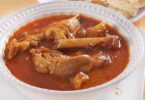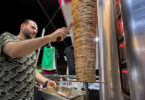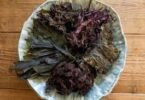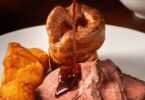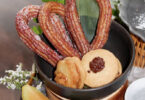Jeremy Lee
When Jeremy Lee received the very first copy of his new cookbook from his publishers, he immediately threw it in a drawer, then cycled from his home in east London to get on with his day at Soho’s Quo Vadis, where he is chef-patron. The book, Cooking: Simply And Well, For One or Many, was the result of many years of work, on and off, and he wasn’t quite ready to face its reality.
Loved by the London food world since making his mark at Terence Conran’s Blueprint Cafe, it seems like an oversight that Lee has not published a cookbook until now. “I had shied away, I suppose, mostly because I thought it had all been done. God knows that this kind of thing is standing on the shoulders of the great and the many,” he says, gesturing to the shelves on all walls of his home. They’re filled with books about food, from nouvelle cuisine pioneer Michel Guérard to current London pastry sensation Ravneet Gill. And of course, the holy trinity of Elizabeth David, Julia Child and Jane Grigson. But Lee had long felt a volume of his own work may be simmering away, and when approached by Fourth Estate in about 2016 he knew it was time to make it real, eventually.
“It’s been a great adventure, but I underestimated entirely what it would take,” he admits. The pressures of writing daily menus and working in a busy kitchen meant that structuring a whole book seemed overwhelming. Lee hastens to add that at least it didn’t take 20 years to put together, like Alan Davidson’s Oxford Companion to Food.
The book is arranged with a chef’s eye for ingredients, and favourite things to eat throughout the seasons, rather than in courses or meals. A chapter on blood oranges sits between Biscuits and Breadcrumbs, while Impromptu Dinners provides meals (such as a perfect pork chop and pan juices) that can be made for one or scaled up; and there are simple, joyous meals to feed a crowd (little meatballs, or fennel and lemon spaghetti).
It’s also a journey through Lee’s career, from his signature snack of baked salsify, back to a classic pommes anna from his time at the London club Boodles, as well as a tribute to peers, mentors and his food-loving parents, who would think nothing of driving across Scotland for hours to pick up a good lobster. “We only liked food folk,” he says. “If you weren’t eating it, you were talking about it.”
As anyone who has seen him laugh and charm his way through the room at Quo Vadis would expect, Lee is as generous in prose as he is when talking about the book, heaping praise on the close team who helped bring it all together. Lee and friends shot the photographs for the book at his home, for a true reflection of his cooking – the chocolate tart is a little spilled, the pastry a little blond, the plates and cookware his own. “It’s all very real,” he says. “We’re keen on that.”
Despite his slow start, in the end Lee over-delivered with his manuscript, and some favourite recipes were lost to the editing process. Mince and tatties did not make the cut. He wonders if calling it “Scottish ragu” would have improved its chances of making the final version and if, perhaps, it could go in a second book. “We’ll see how this darling does. It’s all a bit nerve-racking,” says Lee, breezily. “The adventure continues.”
Sardines on toast with a fried egg (pictured above)
Worth considering too for this charming dish are mackerel and herring, cooked similarly.
For each person
spring onions 3, trimmed
bread 1 slice
butter
olive oil 1 tsp
fresh sardines 3, butterflied (ie split and flattened)
organic egg 1
Heat a griddle or frying pan over a high heat. Lay the spring onions on the hot pan to blister, turning after 3-4 minutes to blister the other side.
Toast the bread and chop the cooked spring onions finely. Butter the toast and spread with the chopped spring onions.
Lightly oil and season the skin side of the sardines, then lay them in the onion pan, skin side down, and cook undisturbed for 3-4 minutes, until the flesh turns pale. Flip and cook for no more than 1 minute on the other side.
Heat a small frying pan and gently fry the egg. Carefully lift the sardines and set them skin side up on the onion, then place the egg on the sardines – et voilà.
Pork chop
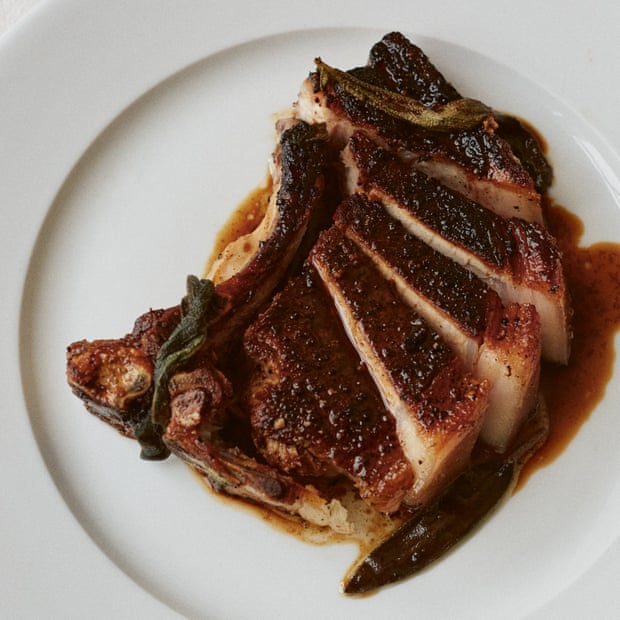
For each person
pork chop 1 x 300-400g, preferably on the bone
light vegetable oil 1 tsp
garlic ½ clove, peeled and finely chopped
unwaxed lemon zestof ½
thyme leaves a pinch
rosemary 2-3 sprigs
fennel seeds and celery seeds a pinch of each
very good red wine vinegar 1 tsp (such as Banyuls)
Heat a cast-iron frying pan over a moderate heat. Liberally and evenly pepper the pork chop on both sides and lightly season with sea salt. Put the oil into the cast-iron pan, lay the pork chop on top and let cook undisturbed until deep mahogany in colour, roughly 8-10 minutes.
While the pork chop is cooking, grind the garlic, lemon zest, thyme and rosemary with the fennel and celery seeds in a pestle and mortar and set aside.
Turn the pork chop and cook for a further 2-3 minutes. Remove the pan from the heat and spoon the contents of the mortar on to the chop. Discard any excess fat from the pan, pour the red wine vinegar on to the chop, and turn it a few times to make sure it’s evenly coated. Cover and set aside to rest in the pan for at least 3-4 minutes.
Gently warm the pan to heat up any juices gathered, to pour over the pork chop before serving. The chop goes wonderfully with so much, from olive oil, mash or potato and celeriac gratin to green beans, asparagus, peas, courgettes, Jerusalem artichokes or chicory.
Hake with parsley, dill and anchovy sauce
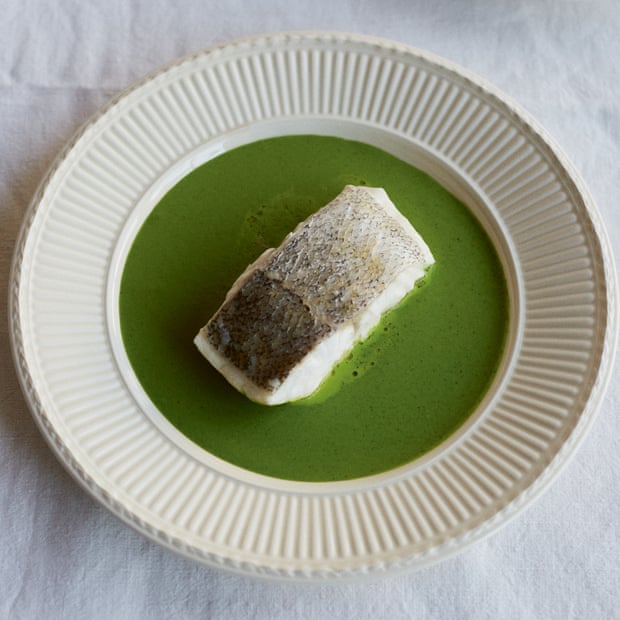
A striking dish with the pale green sauce pooled in the plate, contrasting with the delicate silvered skin of the hake.
Feeds 6
shallots 3 small
garlic 1 clove
anchovy fillets 6
olive oil 7 tbsp
double cream 200ml
flat-leaf parsley 150g picked leaves
dill 30g picked leaves
hake 6 fillets, roughly 1kg in total
Preheat the oven to 180C fan/gas mark 6.
Peel and finely chop the shallots and garlic. Place in a pan with the anchovies and olive oil. Sit this upon the gentlest heat and warm until the shallots have softened and the anchovies have melted.
Pour in the cream. Bring to a simmer, then pour into a blender packed with the picked herbs. Render smooth and pour this through a fine sieve. Cool swiftly and refrigerate until required.
Place the fillets of hake in a deep ovenproof dish, lightly season with salt and white pepper and lightly dress with a soup spoon of olive oil. Pour in enough cold water to cover the bottom of the dish.
Cover the dish and bake in the hot oven until done, say 15-20 minutes. Remove from the oven and keep warm. Any residual juices left in the dish can be added to the sauce.
Warm the sauce and pour on to a dish. Place the fillets of hake on the sauce and serve swiftly. Heaven with the first crop of new potatoes.
Pommes anna
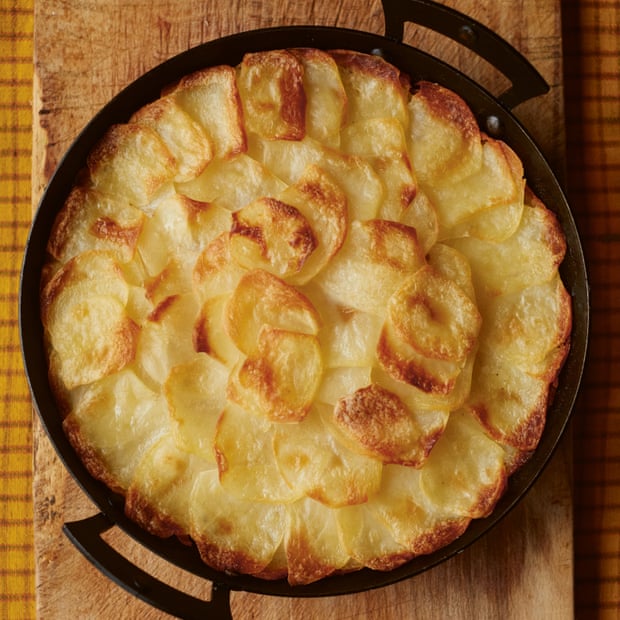
The anna makes a splendid cake, perfect when cut into wedges and served with cuts of beef such as bavette, onglet, rump and loin, or fillet of lamb, hogget, mutton, pork and venison, and, of course, it goes very well with roast chicken.
I have often thought about a copper mould for making this lovely dish, as pleasing to look at as it is to eat. A wider, shallower cake shaped and cooked in a cast-iron skillet or frying pan is as delicious as those cooked in hatted moulds.
The sliced potatoes require clarified butter, which is easy enough to make. Melt some butter in a saucepan over a moderate heat and spoon away any foam or whey that rises. Carefully ladle the butter through muslin into a bowl, leaving behind the white solids.
Mayan gold and yukon gold potatoes cook a treat in this recipe, king edwards work very well, and good results were also enjoyed with baking and roasting potatoes.
Feeds 6
potatoes 2kg, such as yukon gold, mayan gold or king edward
unsalted butter 200g, clarified and kept warm
Put a baking sheet in the middle of the oven and preheat the oven to 200C fan/gas mark 7.
Peel the potatoes and slice thinly (a mandoline makes short work of this).
Place a 25cm cast-iron skillet over a gentle heat. Pour in a small ladle of clarified butter. Place a potato slice in the centre of the skillet and lay the rest of the slices around, overlapping. Continue thus until reaching the edge. Pour over a little more clarified butter and season evenly. Repeat with another layer of potato, continuing thus, adding butter, salt and black pepper as you go. Cover with a sheet of foil and place a lid on top.
Place on the baking sheet in the oven and bake for 45 minutes. Lift the lid and remove the foil. Press the cake down lightly with the bottom of a frying pan, then cook for a further 30 minutes, until the edges of the cake have coloured deep gold.
Insert a small knife into the cake for doneness; there should be no resistance. Remove the cake from the oven, press down lightly with a frying pan one last time, then let sit for 5 minutes.
Carefully work a spatula round the edges, lifting slightly to loosen the cake. Work the spatula gently towards the centre to free any slices that are sticking. Shake the pan gently to see if the cake shifts free. Place a board or dish on top. With one swift move, invert. Tap the bottom of the skillet. Lift the skillet away and serve.
Chocolate, almond and marmalade tart
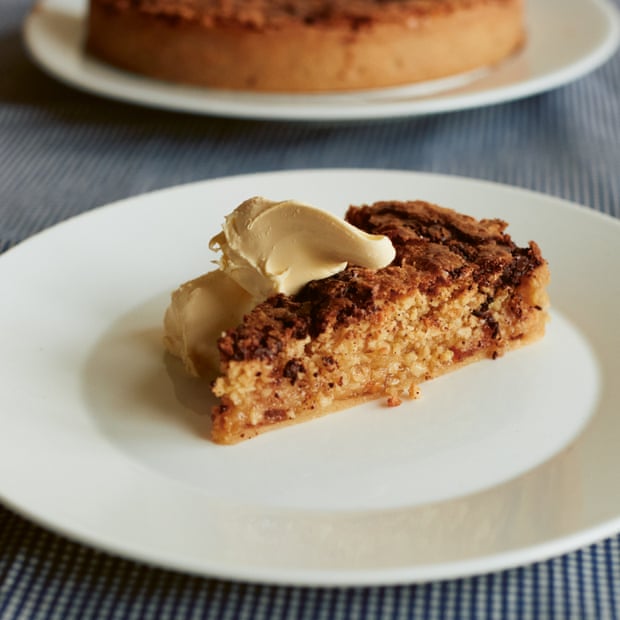
At the restaurant, we like to spread marmalade on a tart case, dot with frangipane, then strew with chocolate and bake. Served with cream, ice-cream and custard, this is very good in those last days of winter when a treat is often much needed. A thought for the cook is to prepare it the day before, as frangipane cooks best when refrigerated. Any leftover pastry can be sliced thinly, laid on a baking sheet and baked in a low oven until crisp and lightly coloured, making rather wonderful biscuits.
Feeds 6
sweet shortcrust pastry (see below)
flour a little for dusting
marmalade 4 tbsp
best dark chocolate 125g, at least 70% cocoa solids, cut into small pieces
For the frangipane
unsalted butter 250g, softened
caster sugar 200g
organic eggs 2
whole almonds 250g blanched, coarsely ground
For the sweet shortcrust pastry
cold butter 150g
00 flour 250g, plus extra for dusting
icing sugar 75g
salt a pinch
organic egg 1
cold water 1 tsp
To make the pastry, put the cold butter, the flour, sugar and a pinch of salt into the bowl of a food processor and render to a fine crumb. Add the egg beaten with the water and pulse until a dough forms. Place the dough on a lightly floured work surface and knead deftly into a drum shape. Cut the dough in half, then gently press down to form a disc. Wrap each disc, and freeze one for another time. Refrigerate the one you are using for at least 30 minutes. Each will fit a 20-25cm x 4-5cm tart case.
To make the frangipane, beat the butter and sugar together in a bowl until mixed. Crack the eggs into a jug and beat lightly. Pour into the beaten butter and sugar. Stir in the ground almonds. Mix all together thoroughly and refrigerate, preferably overnight.
On a lightly floured surface, roll out the pastry large enough to line a 25cm x 2.5cm tart case with a removable bottom. Pop this into the fridge until required.
When ready to bake, preheat the oven to 130C fan/gas mark 2. Spoon the marmalade over the bottom of the tart case. Heap the frangipane in little clods over the marmalade. Strew the chocolate over the frangipane.
Place the tart on a wire rack over a tray to catch any butter that may fall from the tart while baking. Bake in the oven for 1 hour. At the end of the hour, lower the temperature to 100C fan/gas mark ½ and bake for a further 20 minutes, until golden and crusted. Remove from the oven and let the tart sit on a rack for at least an hour before serving. It is very good when served just warm.
Apple tarts
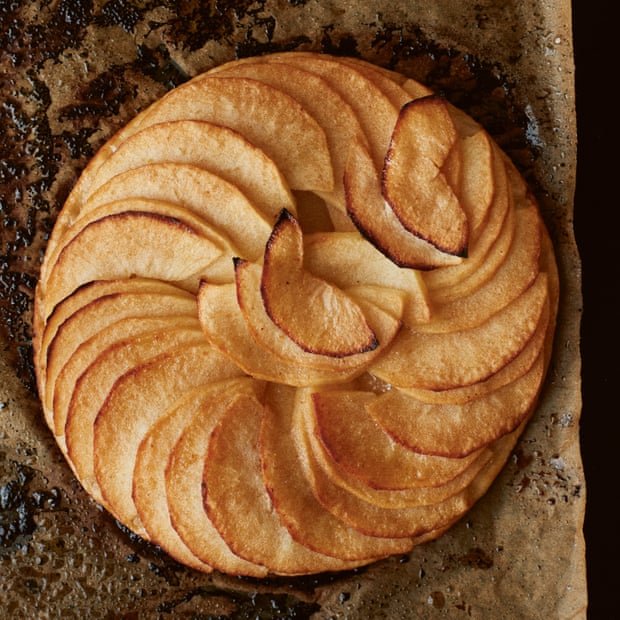
This is a lovely pudding, timeless, elegant and delicious, and simplicity itself.
For each person
rough puff pastry 50g (see below)
apple 1, such as egremont russet, cox’s orange pippin or jonagold
lemon juice a squeeze
unsalted butter 15g, melted
caster sugar ½tsp
For the rough puff pastry
plain flour 500g, plus extra for dusting
unsalted butter 500g, cold, cut into small squares
salt a big pinch
cold water 250ml
To make the rough puff pastry, sift the flour on to a wide surface or into a large bowl. Add the cold butter and salt, then, using your fingertips, work the butter into the flour until it resembles coarse crumbs. Slowly add the water, about 50ml at a time, working deftly until all the water has been added. The dough will not be even but shape it into a rough ball, cover and refrigerate for 20 minutes.
Lightly flour the surface and roll the ball into a rectangle, about 40cm x 20cm. Fold this in three and turn 90 degrees. Roll into the same sized rectangle again and fold in three. Cover and refrigerate for 20 minutes. Repeat this two more times, turning each folded rectangle 90 degrees. Chill the pastry for an hour, or overnight, or freeze for future use.
Preheat the oven to 180C fan/gas mark 6.
Take a 50g portion of the pastry and roll it out thinly on a lightly floured surface into a 12-13cm disc. Place on a baking sheet and prick with a fork. Refrigerate.
Peel and core the apple, halve it, slice the halves thinly and toss in lemon juice. Lay these concentrically and fairly evenly over the pastry. Brush the apple with melted butter. Evenly sugar the apple slices. (These keep remarkably well in the fridge if necessary.)
Bake in the hot oven for 25 minutes until slightly risen and golden. Serve with very good cream.
Courtesy: theguardian


